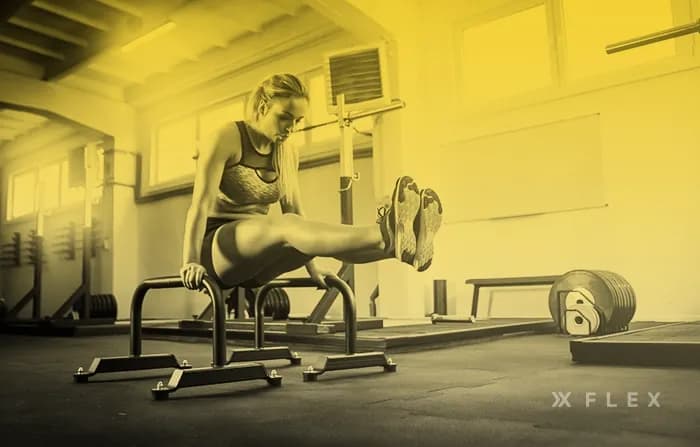L-Sit Progression: A Step-by-Step Guide
This is a simple guide to perfecting your L-sits. Learn beginner to advanced L-sit progressions plus what muscles the L-sit targets.
Here, we’ll walk you through a beginner’s guide to one of the greatest calisthenics moves you can master: The L-sit.
And if you’re at a more advanced level in your L-sit training, give this a read to learn how to take the next step or learn some advanced tips and tricks.
Pssst. We think this is one L that’s really more of a W!
Let’s break down the L-sit. Learn how it can set your core muscles on fire and help your balance and stability.
What is an L-Sit?
The L-sit is a bodyweight-only move that works the muscles of your core. Here, you support your entire body, balancing on your hands so that your torso and legs make an L-shape.
As far as core exercises go, this one is a good rival for the plank, side plank, or planche.
The L-sit is a total-body move that will hit most of the same muscles as these other full-body balance exercises. If you’re a calisthenics enthusiast, the L-sit is a great starting point. It’s simpler than things like muscle-ups, providing an accessible intro to the bodyweight-only technique.
In an L-sit, you are only balanced on your hands as opposed to the hands AND feet. Here, you may need more core and shoulder strength, along with deep focus.
What Muscles Does an L-Sit Work?
The L-sit focuses on your abs to support your whole body.
That being said, there’s a lot more than just core at work here. The L-sit is a total-body movement.
Let’s look at the muscle groups that work together when you come into an L-sit.
Abs
The core and abdominal muscles keep you stable and connect the upper body to the lower body.
This includes your rectus abdominis, transverse abdominis, and internal and external oblique muscles.
Although technically an L-sit is an ab-focused or core move, as we can see, it targets a lot more muscle groups.
Since you're up in the air in a full L-sit, you need to engage your core’s stabilizer muscles. These stop your body from swinging around and knocking you off kilter.
Hip Flexors
Hip flexors help you bring your legs up towards your body. In an L-sit, strong hip flexors will help you hold your position in the air for longer.
Obliques
Obliques help you twist your body side to side but they also keep your core stable. Core stability and strength are necessary for a good L-sit.
Both your internal and external obliques work in this movement.
Shoulders
Did you know the shoulder joint, also called the glenohumeral joint has the biggest range of motion in your body? Your shoulder muscles support the shoulder joint and help you keep this range of motion while preventing injury.
In an L-sit, the shoulders bear a lot of your weight to keep you stable.
Triceps
The triceps muscles at the back of your arms, help to extend your elbows. Focusing on keeping the elbows steady is critical here. This helps to keep your arms fully locked out and support your bodyweight.
Pectoral muscles
The pectorals help move your arms and shoulders. Strong pecs will help with better shoulder stability and arm positioning to keep your body hovered.
Latissimus Dorsi
Lats help you keep your back stable while you extend your shoulders. Since L-sits mean you're hanging in space, your back will engage to keep you stable here as well as your core. The lats also help balance your shoulder blade position.
This move can also hit muscles like the erector spinae in your back, which helps support the spine.
L-Sit Progressions and Variations
Chair L-Sit Variation
This beginner variation is accessible even for those with no calisthenics or bodyweight training background. You can vary the amount of effort you use depending on ability and arm strength level.
To perform this move:
- Sit comfortably in a chair, keeping your back straight.
- Grab the side edges of your chair firmly with your hands.
- Push into the hands and drive through the shoulders, aiming to bring your body up off the chair. Keep your elbows locked out.
- You can try playing around with lifting one or both legs here. But if you don’t feel stable quite yet, simply focus on lifting your body from the chair by any amount.
- Hold this movement at the top.
- Aim for at least 3 sets of 30-second holds.
L-Sit Tuck Variation
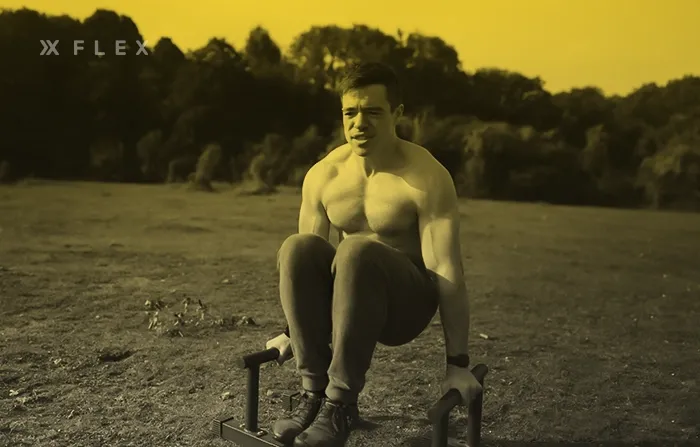
- Sit comfortably on the floor with your legs extended and back straight. Place a yoga block by each hand.
- Press your flat palms firmly down into your yoga blocks.
- Push into the hands and drive through the shoulders, aiming to bring your body up off the ground. As you bring your body up, bend the knees in towards your chest. Keep your elbows locked out.
- Hold this movement at the top, keeping your knees bent.
- Aim for at least 3 sets of 30-second holds.
Because you are holding up a shorter amount of your legs, your core needs to do less work in this variation. Hugging your knees up close to your rib cage may also help with hip pain. If you struggle with hip mobility, this puts less strain on your hip flexors.
Yoga Block L-Sit Variation
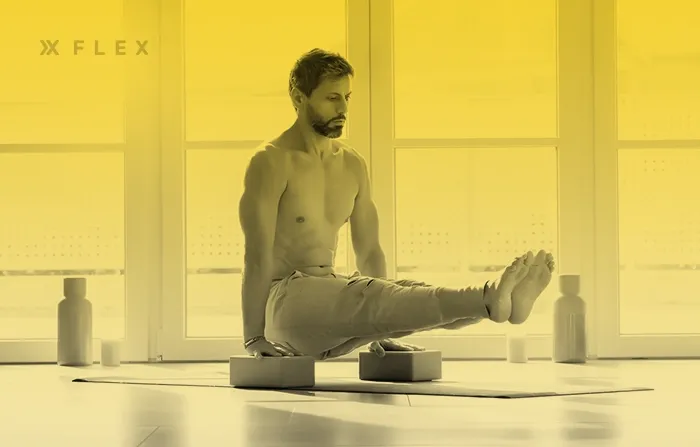
Here, you work your L-sit with your legs extended from the floor, but your arms stay elevated.
- Sit comfortably on the floor with your legs fully extended and back straight. Place a yoga block by each hand.
- Press your flat palms firmly down into your yoga blocks.
- Push into the hands and drive through the shoulders, aiming to bring your body up off the ground. Keep your elbows locked out.
- Hold this movement at the top.
- Aim for at least 3 sets of 30-second holds.
Although you still use your full bodyweight, yoga blocks or some other equipment to lift your body may make it easier. They help keep your spine straight and engage your core muscles.
Pro tip: Use sturdy books, like dictionaries if you don’t have access to yoga blocks and you’re working at home. As long as they're the same height, these can be a good balance tool.
Note: If you have access to parallettes or other calisthenics or CrossFit handles, you may want to try these for elevation instead. This version is less intense than using elevated bars or rings since your body stays close to the ground in case you fall.
Floor L-Sit Variation
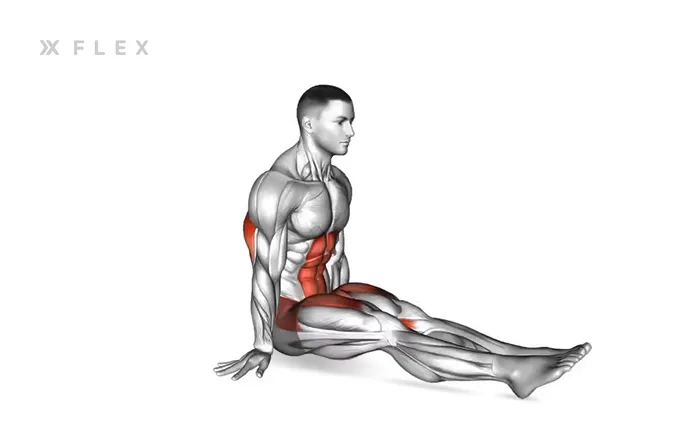
Finally, we’ll progress to a floor L-sit or full L-sit with no equipment.
This variation uses the same technique as the yoga block L-sit only you ditch the blocks, driving only into the floor through the palms of your hands.
It’s important to keep your fingers spread wide here. That way you have more surface area covered to give you a sturdier base to balance on.
Once you master a full L-sit, you may want to try it on hanging rings or elevated parallel bars like a real gymnastics pro!
Remember to always BREATHE during your L-sits. Balance poses like this require a lot of concentration and full focus.
Losing your concentration can throw you off balance, especially if you work up to ring variations, which are less stable.
Breathing helps oxygen hit your muscles and brain, leading to less tired muscles.
Holding your breath will inhibit the flow of oxygen through your body which tires the muscles out.
The type of breathing you perform while you balance matters too! Evidence shows that breathing with intention can help you stay more stable than your natural breathing.
That means breathing consciously versus simply breathing without thinking about it.
Connecting with your breathing can help you stay focused on airflow within your body rather than how hard the L-sit is!
L-Sit Benefits
How does working your L-sit and L-sit progressions benefit your body?
This plank alternative helps work spinal engagement and improve your posture.
Did you know that many of us don’t know how to sit up straight? Let’s do a test. Sit with your legs extended straight out in front of you on the floor and bring your spine up tall to sit up. Think L-sit with no arm balance.
Do you find this hard? Are you experiencing pain in your back?
Many of us will say “yes” to both! It seems unfortunate that sitting up can be such a challenge to many people.
But our modern lifestyles aren’t conducive to great posture. Sitting at desks all day and driving from point A to point B rather than walking doesn’t allow us to focus on holding our heads up high and getting healthy stretches through our spines.
When supported by chairs and other backrests too much, we tend to slouch or slump. This puts a lot of pressure on our spinal vertebrae.
Poor posture doesn’t just hurt your spine. It can cause imbalances in other parts of your body like the hips or shoulders that act to compensate for a struggling spine.
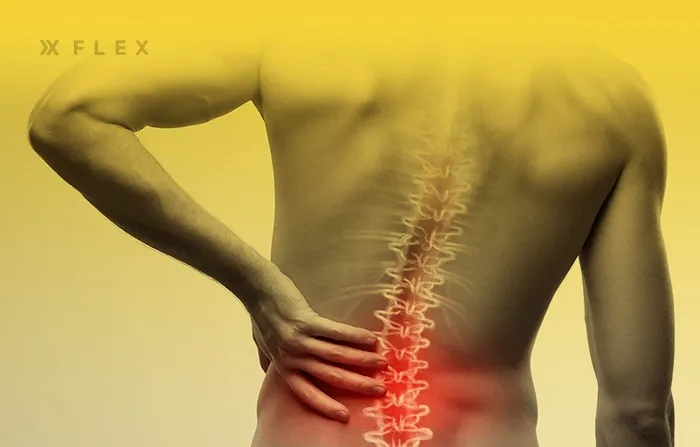
Core work is also great at preventing the buildup of too much body fat. This is especially true for subcutaneous or visceral abdominal fat. These may be dangerous to your health.
Subcutaneous fat sits on top of your gut area, just under the skin. Although it’s mostly unpleasant aesthetically, it can be linked to issues like insulin resistance, high blood pressure, or metabolic conditions.
Visceral abdominal fat is the fat that sits around your gut and crawls between your organs.
Both of these belly fat types can give you a “beer gut” or “muffin top” look. Not only do you get a bloated appearance with higher abdominal fat, it puts a lot of pressure on your heart health.
You may also be at higher risk for issues like heart attack, stroke, or diabetes.
Big Picture
L-sits are a great alternative to common core work like plank holds, sit-ups, or crunches.
This total-body move can get you fit quickly. It also helps you get comfortable with balancing on your arms and can even benefit your focus and breathwork techniques.
Whether you do this move supported with a chair, using yoga blocks, rings, or your hands alone, the L-sit is a great way to improve your posture.
Maintaining proper posture can help you not only look taller, but it can alleviate back pain.
In short, L-sits can:
- Improve your balance
- Reduce the risk of injury
- Target several major muscles at once
- Give you something new to try if you’re sick of strength training
- Help performance in other physical activities
- Improve your body composition
Make sure once you start to improve, you work towards bringing your L-sit to 90 degrees before returning to the starting position. By working with your body weight, the L-sit can be a great way to improve your fitness levels and build your confidence.
You’ll want to sit tight for this one. Flex offers an all-in-one workout platform to help you learn new exercises, visualize your fitness journey, and keep all your PRs in one place.
If you’re feeling a little lazy to work out too, we’ve got you. Working out with a team or other simple motivation tips can help you break out of your lazy spell in no time.
We’ve made it simple to work on customized fitness plans or to introduce a little friendly competition to your fitness community by sharing exercises with your friends. Try it for free through the Flex fitness app.
References
Kim, D., Cho, M., Park, Y., & Yang, Y. (2015). Effect of an exercise program for posture correction on musculoskeletal pain. Journal of physical therapy science, 27(6), 1791–1794. https://doi.org/10.1589/jpts.27.1791
Kim, S. H., Shin, H. J., & Cho, H. Y. (2022). Impact of Types of Breathing on Static Balance Ability in Healthy Adults. International journal of environmental research and public health, 19(3), 1205. https://doi.org/10.3390/ijerph19031205
McCausland C, Sawyer E, Eovaldi BJ, et al. Anatomy, Shoulder and Upper Limb, Shoulder Muscles. [Updated 2023 Aug 8]. In: StatPearls [Internet]. Treasure Island (FL):
StatPearls Publishing; 2023 Jan-. Available from: https://www.ncbi.nlm.nih.gov/books/NBK534836/
Mittal B. (2019). Subcutaneous adipose tissue & visceral adipose tissue. The Indian journal of medical research, 149(5), 571–573. https://doi.org/10.4103/ijmr.IJMR_1910_18
Nauli, A. M., & Matin, S. (2019). Why Do Men Accumulate Abdominal Visceral Fat?. Frontiers in physiology, 10, 1486. https://doi.org/10.3389/fphys.2019.01486
Related articles


Get fit with Flex
Build muscle & lose weight fast for free.
Available on iPhone + Apple Watch
